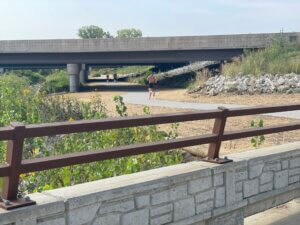

Public Meeting - Cedar Falls, IA
Public Engagement & Meeting Facilitation
Public Engagement: Developing a Unified Vision for Sustainable Growth & Development
Public engagement is a valuable research tool that fosters dialog to balance community wants and needs. It strengthens community connections, builds trust, and guides informed decision-making. It provides the foundation for project success.
At Snyder & Associates, our approach to public engagement begins with a team of experienced planning and design experts and veteran technical staff. Bringing together project-specific subject matter experts and public engagement expertise provides us with the technical knowledge and communication skills needed to address public concerns quickly and efficiently. This approach is also beneficial to providing right-sized solutions that preserve the project intent with your budget in mind.
We specialize in creating engaging ways for community members to participate and share their thoughts and opinions. During engagement, we remain neutral. Our focus is on listening and learning to apply what the public has to say about the project. Using a multifaceted engagement strategy, we strive to ensure that everyone has an equal opportunity to be heard. Our projects benefit from our ability to create momentum, build support, and educate each other on related opinions and issues. As a result, we’re able to develop a unified vision and strategy geared toward sustainable growth and development.
Using Technology to Boost Public Engagement
We believe that successful public engagement begins with open, honest, and regular communication with project stakeholders. Community members are more engaged in the planning process when they play a meaningful role in the deliberations, decision making, and implementation of projects and programs that affect them. By tapping into existing resources including current websites and established social media accounts, we’ll help you leverage the strength of established engagement efforts and build upon them to gather community input. Through a variety of current technology including online surveys and data gathering, virtual reality modeling, and animations, we’ll help you connect with your community.
Snyder & Associates Public Engagement Services
Formal Public Hearings
When the law calls for a public hearing as part of the project process, we can assist with presentations, informational displays, recorded public comments, comment forms, and provisions for postage-paid comment forms for the allotted comment period. All information is documented, including any responses provided.
Open House Public Informational Meetings
Often less formal than a public hearing, an open house is intended to convey project information through the use of videos, displays, and other media to invite attendees to comment. An informal open house setting allows the public to come and go as their schedule allows. Typically, the Snyder team will develop boards or displays for the public to view at different stations, which can be static or interactive depending on project needs and goals. Project professionals will be on hand to answer questions one on one. This setting is often successful in gauging public reactions to new community ideas.
Stakeholder Groups
We can help identify and organize stakeholder groups or project management teams that build community support and provide valuable insight. To foster accurate representation of diverse community populations, stakeholder groups will include individuals from a variety of interests and viewpoints. A broad stakeholder group that serves as the project management team will often meet multiple times over the course of a project.
Online Public Engagement
Online engagement is the easiest and most effective way to reach a wide variety of audiences. We’re skilled in using social media, MetroQuest, Survey Monkey, Poll Everywhere, and other platforms to reach targeted audiences and gather important information. We’re happy to offer survey development via MetroQuest as a stand-alone service. It’s a quick, fun, and powerful tool that can provide valuable project input.
Design Charrettes
We can lead design charrettes with stakeholders that have a vested interest in the outcome of a project. This includes people that manage and maintain the space along with those who will be using it. By working closely on design concepts and details with these stakeholders, the resulting design will meet the needs of everyone involved and address their concerns.
Focus Groups
For detailed public engagement, we lead focus groups sessions based upon the group’s demographics or a specific subject matter. For example, if the group of people most impacted by a potential project are college students, we can create a focus group session solely for that targeted demographic. Alternatively, if a community is concerned about traffic safety on a particular street, we can facilitate a focus group for discussing that topic alone.
Graphics
Communication of project data is easier for the public to understand in a graphic format, instead of text. Graphics can range from charts and graphs to photos, models, and informational mapping.
3D Visualizations & Animations
We use Virtual Reality (VR) technology to illustrate to people what an improvement may look like near and what it will be like. The setup is simple and it helps the general public understand something they may not otherwise be able to visualize on traditional paper concept drawings or preliminary plans.
Virtual Reality Simulations
Virtual reality is changing how we involve stakeholders in the public engagement process. By providing a high-resolution 3D model of a proposed design, VR technology allows stakeholders to experience proposed project outcomes before construction begins. This often results in stronger public support and project engagement.
Pop-up/Piggyback Events
Farmers’ markets, community festivals, and other public events are low-pressure, informal environments ideal for connecting with community members. By piggybacking onto an existing event, we’re often able to gain a great deal of insight and receive feedback from people who may not have participated otherwise.
Construction Updates
Keeping your community up-to-date with construction progress keeps the dialog going beyond initial public engagement efforts and provides a high level of transparency. Webcams and drone photography can be beneficial to detail progress online.
Grassroots Fundraising
Never underestimate the power of grassroots funding for a popular project. While the money generated is typically a small fraction of the overall project cost, these efforts highlight public interest in a project. They also generate infectious energy that spreads the word. Ultimately, the funds can be counted on as matching funds for larger grant streams that require a local match. Many quality of life public improvements, particularly parks and trails, must use a variety of revenue sources to fulfill a budget, and oftentimes volunteer groups lead fundraising efforts. We can help develop a project pitch piece to describe its benefits and the potential return on investment to the community.
Brochures & Flyers
Our graphic design team can provide compelling and informative brochures, flyers, display boards, and other materials that assist with public engagement initiatives.
Project Websites
Provide up-to-date project information in an easy-to-find format via a project website. If you have an existing website that can be used for this purpose, we can provide project content for you to post. In cases where an existing website isn’t suitable for project updates, we can customize, create, and maintain one for the duration of the project.

